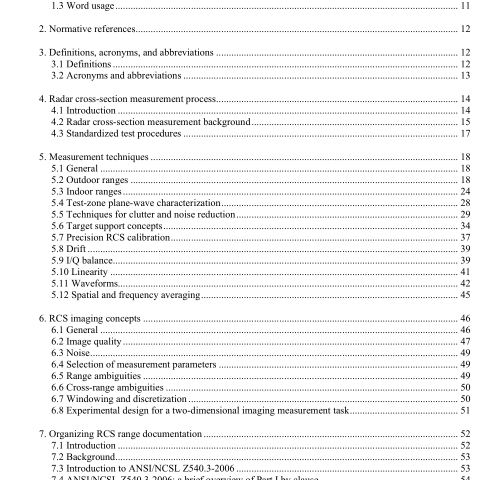IEEE 1502-2020 pdf download.IEEE Recommended Practice for Radar Cross-Section Test Procedures
4. Radar cross-section measurement process
4.1 Introduction
Radar scattering is typically represented as the RCS of the test object. The term RCS evolved from the basic metric for radar scattering: the ratio of the power scattered from an object in units of power per solid angle (steradians) normalized to the plane-wave illumination in units of power per unit area. The RCS is thus given in units of area (or effective cross-sectional area of the target, hence the name). Note that the RCS of the test object is a property of the test object alone; it is neither a function of the radar system nor the distance between the radar and the test object, as long as the object is in the far field. Because the RCS of a target can have large amplitude variation in frequency and angle, it is expressed in units of decibels with respect to a square meter and is abbreviated as dBsm (sometimes DBSM or dBm 2 ).
In terms of this definition, the RCS of a radar target is a scalar ratio of powers. If the effects of polarization and phase are included, the RCS can be characterized by the complex polarimetric scattering (CPS) matrix, which is based on one-half the real part of the complex Poynting vector. The CPS is proportional to a Hadamard product of a 2×2 matrix of the real-valued RCSs corresponding to each of the four combinations of transmit-receive polarizations and a 2×2 matrix of the complex exponentials associated with the phases of the scattered fields for the same combinations of both polarizations (Bhattacharyya, Sengupta [B6], Ruck [B64]). The measurement of the RCS of a test object requires the test object to be illuminated by an electromagnetic (EM) plane wave and the resultant scattered signal to be observed in the far field. After calibration, this process yields the RCS of the test object in units of area or the full scattering matrix (Ruck [B64]) as a set of complex scattering coefficients.
The responsibilities of the range operators from the perspective of this document are listed as follows:
Understand electromagnetic safety requirements (IEEE Std C95.1™-2019 [B33]);
Establish and document procedures for performing test measurements and follow those procedures;
Conduct radar scattering measurements;
Process the raw measurement data for quality assurance and measurement reporting;
Calibrate the system to obtain data in standard units of RCS;
Establish the overall accuracy of the measurement range (the error bars on the RCS measurements);
Determine the accuracy of the measurement instrumentation;
Determine the quality of the illuminating plane wave;
Determine the accuracy of the calibration reference standards;
Deliver the data and documentation to the end user in a usable format.
4.2 Radar cross-section measurement background
4.2.1 Measurement history
Radar reflectivity measurements go back to the earliest days of radar. What are now known as RCS measurements began to be more openly discussed in the literature in the late 1950s and early 1960s (Bachman [B3], Cummings [B13], Currie, Curie [B15], Johnson et al. [B38], Kennedy [B40], Proceedings of the IEEE [B60]), although much of that work was under the auspices of the military and thus not readily available. This situation began to change with the 1965 publication of a Special Issue of the Proceedings of the IEEE [B61], which concentrated on topics associated with radar reflectivity. Several of the 1965 papers in this issue specifically focused on the requirements of RCS measurements, including an overview of the state of the art in RCS measurements (Blacksmith et al. [B7], [B8]). In addition, this issue included papers on range requirements (Kouyoumjian, Peters [B50]), target support issues (Freeny [B26]), measurement techniques (Bachman [B3], Huynen [B29]), and discussions of typical facilities, both static (Marlow et al. [B54]) and dynamic (Olin, Queen [B59]). With the publication of this issue, a growing open-source literature base on RCS measurements became available to practitioners in the field.IEEE 1502 pdf download.IEEE 1502-2020 pdf download
IEEE 1502-2020 pdf download

Leave a Reply